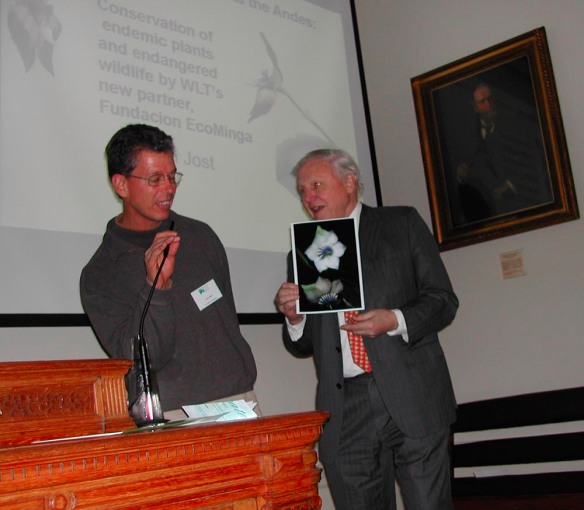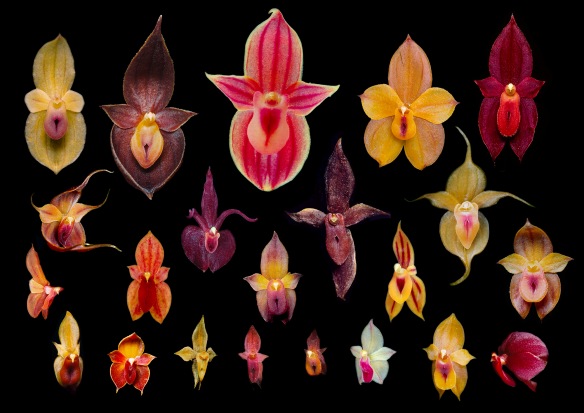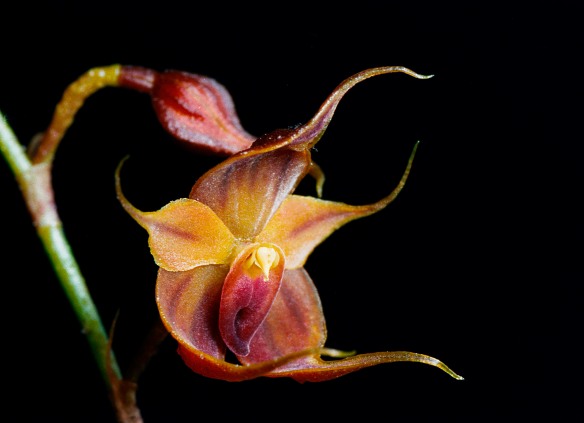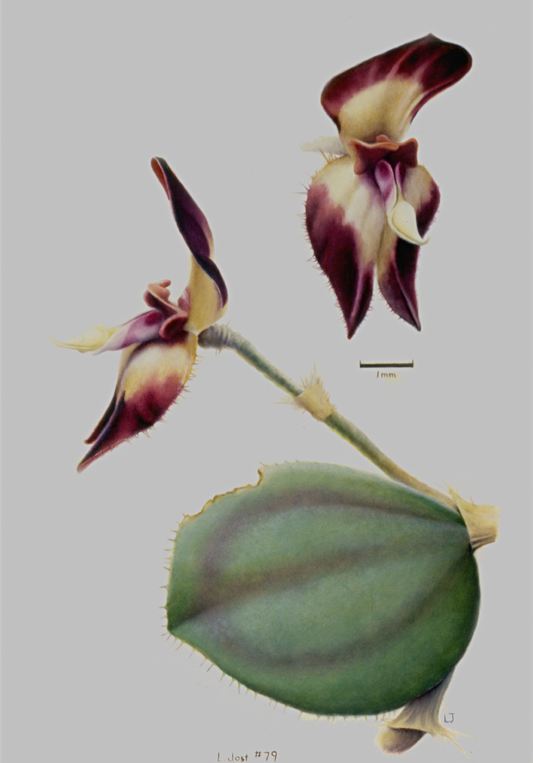
Meriania aurata, a tree species we discovered in what is now EcoMinga’s Rio Zunac Reserve. Flower is large, about 7 cm across. Photo: Lou Jost/EcoMinga
I’m compiling a list of all the plant and animal species discovered by our reserve manager Juan Pablo Reyes, our director Javier Robayo, myself, and our students and co-investigators in and around our EcoMinga reserves near Banos, Ecuador. In this first installment, I’ll deal with the plants. (I’ll be saving some major as-yet-unpublished plant discoveries for a later post.) Nearly all of these species are still known only from our immediate area and nowhere else in the world. Adding these new discoveries to the previously-known locally endemic plants of the area, there are now more plant species unique to this area (the upper Rio Pastaza watershed) than there are in the world-famous Galapagos Islands! This is one reason why we are so committed to its conservation.
I’ll start with two spectacular new species of trees in the melastome family, Meriania aurata and Blakea attenboroughii. Meriania aurata (above) is the most spectacular tree I have ever seen. Imagine big heavy inflorescences half a meter across whose stems look as if they are made of bright shiny yellow plastic, each yellow winged stem carrying an orange rosebud, which becomes a short-lived bright salmon flower 7 cm across with a bizarre row of anthers lined up under the stigma. I first noticed fallen buds of this species here in the Banos area in the 1990s, but that was before I realized just how special the area was. I wrongly assumed that such a dramatic flower must be well-known. By 2001 I understood the area better, and I organized a 15-man expedition to reach new elevations in the Rio Zunac watershed (now part of our Rio Zunac Reserve). David Neill, the renowned Ecuadorian tree expert, came along. We saw this tree; he recognized it as a new species (the sister species of the also-beautiful Meriania hernandoi) and published its description (co-authored by Carmen Ulloa). Even so, we did not find a fresh, fully-opened flower, so the paper does not include a full flower drawing (see below). It was only recently that I finally was able to make these close-up photos of the open flowers (with the help of EcoMinga’s agile tree-climbing guards).

Meriania aurata, from the scientific description of the species, Ulloa, Fernandez, and Neill (2007), Meriania aurata (Melastomataceae), una Especie Nueva de los Llanganates, Ecuador. Novon 17: 525-528.
The next species, Blakea attenboroughii from the same family (Melastomataceae) was discovered by Javier Robayo, myself, and Andy Orchard of Puro Coffee, donor to the World Land Trust for the first purchases of our Cerro Candelaria Reserve. I am not an expert in this plant group (I’m an orchid taxonomist), but as soon as I saw it I realized it was something I’d never seen before anywhere. Expert Darin Penneys confirmed it was a new species. We decided to name it after World Land Trust patron and famous BBC TV presenter and conservationist Sir David Attenborough, to thank him for his support for our conservation efforts. I had the pleasure of presenting a picture of it to him at a World Land Trust event in the Linnaean Society headquarters in London, where the centuries-old specimens of Linnaeus, the father of modern taxonomy, are carefully kept. Sir David is a wonderful man.

Me presenting Sir David Attenborough with a photo of his tree, Blakea attenboroughii, in London. Photo: Nigel Simpson.
On to the new orchids! First and foremost was an amazing evolutionary radiation my students and I discovered on the tops of the highest mountains in the area. At the time I started exploring, the orchid genus Teagueia had only six species in the world, three in Ecuador and three in Colombia. But here on these few mountaintops around Banos we discovered THIRTY new species of this genus!

Some of the thirty new species of Teagueia orchids my students and I discovered on the mountaintops here. You can see a high-resolution printed version of this picture on p 2545 of the Dec 2012 issue of the journal Ecology. Click to enlarge.
One single mountain, which eventually became our Cerro Candelaria Reserve, had 16 of these new species! They are currently the subject of several ecological and evolutionary studies. It is an unprecedented local speciation event. So far taxonomist Carl Luer and I have described six of the thirty species, including one named after Puro Coffee and another named after the mother of Albertino Abela, in honor of their very important donations to the World Land Trust for EcoMinga, which let us preserve these mountain peaks for posterity.
There are lots more new orchids….here are the citations for some of the first ones I discovered in the Banos area, published in Dr Carl Luer’s many volumes of orchid monographs for the Missouri Botanical Garden. (Note: Carl decided to name some of them after me…NOT my idea, though I am honored!)
Luer, C. A. 2002. Icones Pleurothallidinarum XXIV: A First Century of New Species of Stelis of Ecuador, Part 1. St. Louis: Missouri Botanical Garden:
Lepanthes exigua Luer and Jost, p. 94.
Luer, C. A. 2000. Icones Pleurothallidinarum XX: Sytematics of Jostia, Andinia, Barbosella, Barbodria, and Pleurothallis subgen. Antilla, subgen. Effusia, subgen. Restrepioidia. St. Louis: Missouri Botanical Garden:
New genus Jostia Luer, p. 1.
L. tetrachaeta Luer and Jost, p. 119.
Teagueia alyssana Luer and Jost, p. 131.
T. cymbisepala Luer and Jost, p.132.
T. jostii Luer, p. 132.
T. sancheziae Luer and Jost, p. 133.
Luer, C. A. 1999. Icones Pleurothallidinarum XVIII: Sytematics of Pleurothallis subgen. Pleurothallis sect. Pleurothallis subsect. Antenniferae, subsect. Longiracemosae, subsect. Macrophyllae-Racemosae, subsect. Perplexae, subgen. Pseudostelis, subgen. Acuminatia. St. Louis: Missouri Botanical Garden:
Lepanthes abitaguae Luer and Jost, p. 139.
L. aprina Luer and Jost, p. 139.
L. barbigera Luer and Jost, p. 140.
L. elytrifera Luer and Jost, p. 140.
L. hispidosa Luer and Jost, p.141.
L. hydrae Luer and Jost, p. 141.
L. jostii Luer, p. 142.
L. marshana Luer and Jost, p. 142.
L. privigna Luer and Jost, p. 143.
L. ruthiana Luer and Jost, p. 147.
L. staatsiana Luer and Jost, p. 147.
Luer, C. A. 1998. Icones Pleurothallidinarum XVII: Sytematics of Subgen. Pleurothallis sect. Abortivae, sect. Truncatae, sect. Pleurothallis subsect. Acroniae, subsect. Pleurothallis, subgen. Dracontia, subgen. Unciferia. St. Louis: Missouri Botanical Garden:
Lepanthes ariasiana Luer and Jost, p.104.
L. mooreana Luer and Jost, p. 106.
L. serialina Luer and Jost, p. 107.
L. viebrockiana Luer and Jost, p. 108.
Scaphosepalum jostii Luer, p.116.
Some more recent discoveries or co-discoveries of mine in the Banos area include Masdevallia stigii, M. loui, Stellilabium jostii, Trichosalpinx jostii, Lepanthes spruceana, L. ornithocephala, L. mayordomensis, L. pseudomucronata, and quite a backlog of species I still haven’t had time to describe and publish.
All these discoveries in an area only 20 km x 40 km (12.5 miles x 25 miles), smaller than many cities! A paradise for botanists. And as we’ll see in the next installment, a paradise for herpetologists too.










Lou, what a wonderful world of shapes and colors! What a wonderful discovery! Congratulations to you and to all the people involved in such great good news!
Mónica y Juan
Gracias Monica y Juan!
As Henry David Thoreau said, “heaven is under our feet as well as above our heads”. A place with such great biodiversity is indeed a paradise for all human beings.
Yes, this is our heaven!
Pingback: New species discovered by EcoMinga staff and co-workers, Part 1: Plants » Howard Teich Howard Teich
Pingback: TWO new Magnolia species discovered in our Rio Zunac Reserve! | Fundacion EcoMinga
Pingback: Quick visit to our Rio Zunac field station | Fundacion EcoMinga
Pingback: New species discovered by EcoMinga staff and co-workers, Part 2: Frogs | Fundacion EcoMinga
Pingback: New short film about Puro Coffee’s involvement in our Cerro Candelaria Reserve | Fundacion EcoMinga
Pingback: World Land Trust “Big Match” campaign for EcoMinga: “Forests in the Sky”, October 1 to 15 | Fundacion EcoMinga
Pingback: Two more new frogs discovered in our Rio Zunac Reserve | Fundacion EcoMinga
Pingback: Visit to our Rio Zunac magnolias | Fundacion EcoMinga
Pingback: Melastomes 3: Our first discovery of a tree species new to science, Meriania aurata | Fundacion EcoMinga